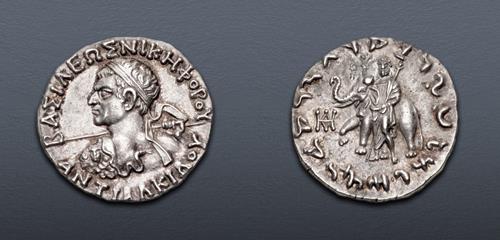|
BAKTRIA, Indo-Greek Kingdom. Antialkidas Nikephoros. Circa 130-120 BC. AR Tetradrachm (26mm, 9.79 g, 12h). BAΣIΛEΩΣ NIKHΦOPΟΥ ANTIAΛKIΔOY, diademed heroic bust left, seen from behind, with aegis on left shoulder, brandishing spear in right hand / maharajasa jayadharasa amtialikitasa in Kharosthi, Zeus standing facing slightly left, holding in his right hand Nike, who stands right on a globe and holding wreath, and cradling scepter in his left arm; behind, elephant standing slightly raised right with trunk raised; monogram to left. Bopearachchi 8A; Bopearachchi & Rahman –; cf. SNG ANS 1057 (for rev.); MIG Type 274a; HGC 12, 254 (this coin illustrated). Attractive iridescent tone. EF. A high grade example with an exceptional portrait. Extremely rare as such.
From the Archytas Collection. Ex William and Louise Fielder Collection (Triton VIII, 11 January 2005), lot 660.
INTRO NOTE Formed over the past thirty years, the Archytas Collection represents one of the finest holdings of Kushan coins in private hands. Replete with coins of exceptional quality, extreme rarity, and considerable historical and iconographic interest, this dedicated collector has created an extraordinary numismatic record of the Kushan Empire which flourished in Central Asia from the first to the fourth centuries AD.
The name Kushan derives from the Chinese term Guishuang, used to describe one branch of the Yuezhi, a loose confederation of Indo-European people who had been living in the Xinjiang Province of modern China. Driven west by the Xiongnu nomads between 176 and 160 BC, the five groups of the Yuezhi – the Xiumi, Guishuang, or Kushans, Shuangmi, Xidun, and Dumi – reached the Hellenistic kingdom of Baktria by 135 BC. They expelled the ruling Greek dynasties there, forcing these kings farther south to settle along the Indus River. In the following century, the Guishuang bound the other tribes of the Yuezhi into a powerful state. As the Guishuang, or Kushans, were the predominant power, their name became that by which the entire confederation was known. At its height, the Kushan Empire encompassed most of modern-day Afghanistan and Pakistan, as well as large parts of northern India, Uzbekistan, Turkmenistan and Tajikistan. Diplomatic ties were maintained with the empires of Rome to the west and China to the east.
The earliest Kushan coins were struck to the same standards of the issues of Indo-Greek kingdoms that the Kushans conquered. They comprised mainly tetradrachms and drachms in silver and bronze with legends in Greek. Under Vima Kadphises, a major reform resulted in the introduction of a spectacular gold coinage of dinars weighing approximately eight grams along with multiples and fractions. The types extolled the might of the Kushan kings and their religious affinities. The earliest gold dinars bore legends solely in Greek, subsequent issues had legends in both Greek and Kharoshti. As the empire grew to its greatest extent under king Kanishka, the Kushan language, written in adaptation of the Greek alphabet with some local alterations, was increasingly used.
Like their Roman contemporaries, the Kushans incorporated much of the culture and religion of the many varied peoples they ruled into their own. With an empire straddling the cross roads of the ancient world, the Kushan pantheon came to represent an unparalleled syncretism of western and eastern elements. The Kushan gold coinage displays this remarkable diversity to the fullest extent as evinced by the Archytas Collection. Greek gods and heroes appear alongside fertility gods of ancient Iran. Siva, greatly revered by king Vima Kadphises, and other Shaivite gods of the Indian Subcontinent compete with deities and avatars of Zoroastrianism. The Buddha, championed by king Kanishka I, takes his place as do deities linked to Sumerian, Akkadian, and ancient Egyptian beliefs. As time passed, and the fortunes of the empire waned, the coinage witnesses a shrinking of this broad pantheon till only Siva, accompanied by his faithful Nandi bull, and Ardoksho, the great goddess of fertility and wealth, remain.
After the death of Vasudeva I in AD 225, the Sasanian Empire under Ardashir I conquered Kushan lands in Baktria and northern India. The southern portion of this territory remained under direct Sasanian control, while in the north arose the Kushanshahs, or Kushano-Sasanians, Sasanian nobles who ruled the region as vassals, striking broad flan dinars blending Kushan and Sasanian elements. By AD 270, Kushan control of the Ganges plain was ceded to the rising Gupta kingdom and by AD 320 the Guptas were pressing on the last remaining Kushan-held territories. During this period, several rebel leaders and generals appeared, further weakening the Kushan state. By the middle of the fourth century AD, the former Kushan vassal, Kidara, absorbed the now-moribund Kushan Empire into his dominions. Kushan style dinars continued to by struck by the Kidarites and subsequent dynasties for hundreds of years.
The final winners of all Triton XXV lots will be determined at the live public sale that will be held on 11-12 January 2022. Triton XXV – Session Two – Greek Coinage (Part 2) through Roman Provincial Coinage will be held Tuesday afternoon, 11 January 2022 beginning at 2:00 PM ET.
Winning bids are subject to a 20% buyer's fee for bids placed on this website and 22.50% for all others.
We recognize that our users may have various Internet Browsers and Operating Systems. We like our visitors to have the best possible experience when using our bidding platform. However, we do recognize that it is impossible to develop applications that work identically, efficiently and effectively on all web browsers. The CNG bidding platform supports the latest stable major version and the stable previous version of Mozilla Firefox and Chrome.
|
